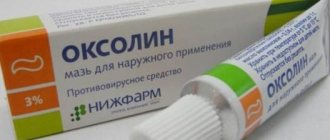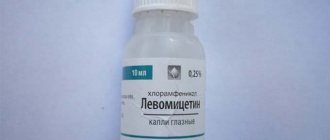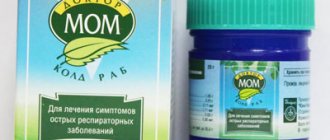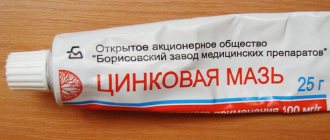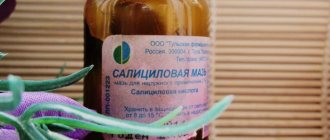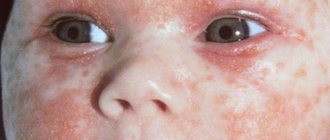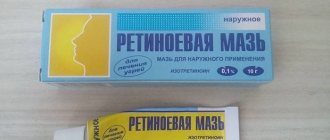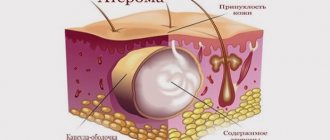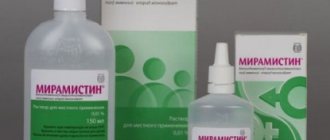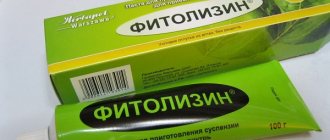Indications and contraindications
The advantage of this antibiotic is the minimum number of contraindications. Their list includes the following pathologies and special conditions:
- pregnancy;
- allergy to the components of the drug;
- lactation period.
Indications for the use of Floxal are the following infectious and inflammatory diseases of the anterior part of the eyes caused by microorganisms sensitive to ofloxacin:
- chlamydial eye infection;
- conjunctivitis;
- barley;
- dacryocystitis;
- keratitis;
- blepharitis;
- corneal ulcer.
The drug is used for the treatment and prevention of bacterial infections, conditions after surgery and eye injuries.
Hypersensitivity to the components of the drug, pregnancy, lactation.
Floxal is used to treat infections caused by microorganisms sensitive to the drug. It is capable of destroying staphylococci, streptococci, pseudomonas, neisseria, shigella, enterobacteria, chlamydia, mycoplasma and many other bacteria.
Indications for use of ointment:
- blepharitis - purulent inflammation of the eyelids;
- dacryocystitis - damage to the lacrimal sac;
- bacterial conjunctivitis;
- keratitis and creeping corneal ulcer;
- blepharoconjunctivitis;
- chlamydial eye lesions.
The drug is also used to treat styes and meibomites. These diseases are characterized by the appearance of pustules on the eyelids. Strong antibiotics help fight inflammation and even avoid surgery. Floxal ointment for barley should be used in the first few days after its appearance. If treatment is ineffective, the pus must be evacuated surgically.
As for contraindications, the drug is not recommended for use during pregnancy and breastfeeding. It should not be given to people who have individual intolerance to the components of the ointment.
- allergic reactions;
- transient conjunctival hyperemia;
- burning sensation, discomfort in the eyes;
- itching and dryness of the conjunctiva;
- photophobia;
- lacrimation;
- dizziness.
Phloxal has its own peculiarity. It is used to eliminate infections, inflammatory processes and as a preventive measure for diseases that can affect the eyes.
This drug is mainly prescribed in situations where it is not possible to examine the infected area of the eye.
It is appropriate to use as a prophylactic for:
- Injury to the eye, wound, after a foreign body enters the eye, which violates the integrity of the eye.
- After eye surgery, to avoid possible infection.
It is recommended to use it as a medicine for:
- If the edges of the eyelashes are affected by the inflammatory process.
- When inflammation occurs on the mucous membrane of the eye (conjunctivitis).
- Barley or inflammation with purulent discharge.
- Frequent blockage of the sebaceous glands (purulent chalazion).
- Purulent inflammation of the lacrimal sac, which is accompanied by the formation of pus (dacryocystitis).
- Corneal ulcers and inflammatory processes on it (keratitis).
- Eye infections caused by chlamydia.
Floxal is used only for external treatment. Its introduction inside is not allowed.
The product is indispensable in advanced situations of infection of bacterial origin. In such cases, Floxal is used in complex therapy with antiviral agents. In very advanced cases, the dosage is increased by the doctor.
Before using drops, be sure to study the application features and main contraindications:
- Do not use if you have an allergic reaction to fluoroquinalone drugs. But the attending physician can select an analogue of the drug.
- Not recommended during breastfeeding and pregnancy in any trimester. The drug is contraindicated due to insufficient knowledge of its use in such situations.
- Do not use in the treatment of chronic conjunctivitis and blepharitis of non-bacterial origin.
Indications for use
Floxal is prescribed in the treatment of eye diseases accompanied by suppuration, lacrimation, inflammation and redness.
Can be used as a prophylactic against inflammatory processes, infectious infections after eye injury and surgery.
Drug interactions
- eye drops 0.3%;
- eye ointment 0.3%.
Eye drops 3 mg/ml – a transparent solution of light yellow color.
Composition and packaging:
- active ingredient: ofloxacin 3 mg;
- excipients: sodium chloride - 9 mg, 1M chloride acid solution - 4.5-5.5 mg, 1M sodium hydroxide solution - 2.5-3.5 mg, benzalkonium chloride - 0.025 mg, water for injection - up to 1 ml .
Drops are available in 5 ml polyethylene bottles with a dropper cap; each bottle is placed in a cardboard box along with instructions for use.
Eye ointment 3 mg/1 g is homogeneous and has a light yellow color.
Composition and packaging:
- active ingredient: ofloxacin 3 mg;
- excipients: white petroleum jelly – 847 mg, liquid paraffin 100 mg, wool fat – 50 mg.
The ointment is available in 3 g tubes, each tube is placed in a cardboard box.
- discomfort and burning in the eyes;
- dryness and itching of the conjunctiva;
- transient conjunctival hyperemia;
- lacrimation;
- photophobia;
- allergic reactions;
- in rare cases - dizziness.
https://www.youtube.com/watch?v=2kK04pglzho
There is no information on interactions with other drugs.
The instructions for use of the drug do not contain data on its interaction with other drugs. For this reason, there are no restrictions on their use. Such conditions are explained by the fact that the drug is indicated for local treatment, which is why it is poorly absorbed into the bloodstream. Against this background, the drug cannot affect the use of other medications.
Judging by the reviews, pronounced reactions after regular use of drops or ointments are rare, and most of them are reversible. Immediately after the procedure, temporary visual impairment is observed. It recovers within a few minutes. Other possible adverse reactions:
- dizziness;
- nausea;
- conjunctival hyperemia;
- burning in the eye;
- swelling of the oropharynx;
- swelling of the face;
- keratitis;
- irritation;
- dry eyes;
- photophobia;
- anaphylactic reactions;
- blurred vision;
- feeling of discomfort in the eyes.
The ointment contains ofloxacin as an active ingredient. This component is an antibiotic from the group of fluoroquinolones of the 2nd generation. It has a wide spectrum of antibacterial activity, thanks to which it effectively fights many infectious eye diseases.
Ofloxacin kills bacteria by disrupting DNA synthesis in their cells. Since inflammatory eye diseases develop due to the penetration of microbes, the death of the latter leads to recovery. Thus, Floxal destroys the infection.
In addition to ofloxacin, the ointment contains:
- white Vaseline;
- liquid paraffin;
- lanolin.
Auxiliary components are necessary to give the ointment the desired appearance and consistency. Thanks to them, the drug is well stored and becomes convenient to use.
Release form Floxal:
- eye ointment: homogeneous, color – light yellow (3 g in tubes, 1 tube in a cardboard box);
- eye drops: transparent, color – light yellow (5 ml in polyethylene bottles with a dropper cap or dropper bottles, 1 bottle or dropper bottle in a cardboard box).
Composition of 1 ml eye drops:
- active ingredient: ofloxacin – 3 mg;
- additional components: 1M sodium hydroxide solution – 2.5–3.5 mg, 1M hydrochloric acid solution – 4.5–5.5 mg, sodium chloride – 9 mg, benzalkonium chloride – 0.025 mg, water for injection – up to 1 ml .
Composition of 1g eye ointment:
- active ingredient: ofloxacin – 3 mg;
- additional components: white petroleum jelly – 847 mg, liquid paraffin – 100 mg, wool fat – 50 mg.
There is no data on the interaction of Floxal with other drugs.
The medicine is prescribed with other eye drops (for example, ophthalmoferon) for a better therapeutic effect. As a complex therapy, ointment is prescribed together with eye drops.
Floxal is an antibacterial (antimicrobial) drug. Its main active substance is the antibiotic Ofloxacin, which belongs to the group of fluoroquinols.
Quickly kills pathogens such as:
- staphylococcus;
- salmonella;
- coli;
- streptococcus;
- chlamydia;
- spirochete;
- mycoplasma;
- meningococcus
When treated with Floxal, there is no general toxic effect on the body. It can pass into breast milk or into the blood in minimal doses. The therapeutic effect manifests itself very quickly and lasts a long time. The effect can be felt within 10-12 minutes after instillation. The bactericidal effect lasts for at least 5 hours.
https://www.youtube.com/watch?v=0AQ7iz1pzm8
Phloxal for therapy is produced in drops and ointments:
- Phloxal. Eye drops. Container is a sterile dropper-shaped bottle made of plastic. In 1 bottle – 5 ml of 0.3% solution (transparent, may have a slightly yellowish tint). 1 ml of the product contains about 3 mg of the active substance - ofloxacin. Additional components: benzalkonium chloride;
- hydrochloric acid;
- sodium hydroxide;
- water for injections.
- Phloxal. Eye ointment. The medicine is in an aluminum tube. In 1 tube – 3 g of 3% drug. Additional components: liquid paraffin;
- petrolatum;
- lanolin.
A high-quality product must have a uniform consistency and a yellowish tint. Both drops and ointment should not be stored for more than 50 days after opening.
There have been no reports of serious drug interactions.
Floxal can be used with other drops and ointments that are used to treat diseases in ophthalmology. Complex treatment can give a good desired therapeutic effect. Floxal ointments are often used as a cross-drug.
Reviews
Valentina, Perm
Floxal is sometimes used to treat eye diseases in newborns. The ointment was prescribed to my child in infancy for bacterial conjunctivitis. The use of the drug did not provoke any undesirable consequences.
Elizaveta, Nizhny Novgorod
The ophthalmologist prescribed Floxal for the treatment of stye. I used the product for several days. But within the first day the pain, redness and swelling disappeared.
Floxal eye ointment (review) from 150 rub.
Overall
4.4
- Efficiency
- Price
- Safety
- Availability
Pros
- Efficiency
- Convenient packaging
- Price
- Light texture
Cons
- Short shelf life
Pharmacological properties
Floxal is an antibiotic that belongs to the fluoroquinolone group:
- Floxal, thanks to special enzymes, affects the DNA of harmful microbes, destroys protein metabolism in them and exhibits its destructive effect.
- It is characterized by great bactericidal activity against gram-positive and gram-negative bacteria.
The average effect of Floxal shows in relation to:
- Listeria monocytogenes;
- Helicobacter pylori;
- Streptococcus pyogenes;
- Pseudomonas aeruginosa and other bacteria;
- Anaerobic bacteria are practically not sensitive to Flosal;
- Treponema pallidum is completely resistant to Flosal.
When using any form of medication and when applied correctly, the active ingredients are distributed evenly over the affected area. Even when using the drug, the active substance does not accumulate on the membranes of the eye more than permissible standards. 50-60 minutes after using Floxal, its concentration reaches its maximum. And after 6-7 hours it is equal to 0.
Floxal is an antibacterial agent used as local therapy for ophthalmological diseases. The active drug is ofloxacin, an antibiotic from the fluoroquinolone group. The antimicrobial effect of the drug is due to its inhibition of DNA gyrase enzymes in microbial cells.
Like his analogues, phloxal is highly active in relation to most gram -negative bacteria: serratiaspp., Morganellamorganii, neisseriameningitis, shigellaspp., Esherichiacoli, Proteussp., Neisseriagonorhoeae, Klebsiellaspp. almonellaspp., Hemophilusinfluenzae, Legionellapneumophila, Citrobacterspp., Acinetobacterspp., Providenciaspp., Chlamydiaspp., Mycoplasmaspp., Yersiniaspp., Enterobacterspp.
The antimicrobial effect of the drug is associated with the ability of ofloxacin to inhibit the enzyme DNA gyrase, which is contained in the microbial cell. Thus, the drug has bactericidal properties.
Floxal has a broad spectrum antibacterial and bactericidal effect.
Pharmacodynamics
Blocks bacterial cell DNA gyrase. It has high activity against most gram-negative microorganisms (Morganella morganii, E.coli, Providencia spp., Proteus spp., Shigella spp., Legionella pneumophila, Klebsiella spp., Enterobacter spp., Yersinia a spp., Citrobacter spp.
Streptococcus pneumoniae, Enterococcus faecalis, Pseudomonas spp are moderately sensitive to the drug.
Microorganisms that produce beta-lactamase are also sensitive to ofloxacin.
Anaerobic bacteria, except B.Urealyticus, are insensitive to Floxal.
Pharmacokinetics
The therapeutic concentration of Floxal in the eye tissues is achieved with local administration of the drug.
Pharmacokinetic properties of the drug
When applying the ointment topically, its components begin to distribute into the conjunctival area, entering it through the cornea, and then reaching the muscles and sclera of the eye. With prolonged use of the drug, ofloxacin begins to accumulate in the vitreous body, reaching the concentration necessary for effective therapy. When using the optimal amount of the drug, a larger amount of it should be present in the eye tissues. The drug itself is absorbed in the concentration required by the body, so excess drug must be carefully removed.
It is necessary to put the drug correctly
Floxal must be used exactly following the instructions. A strip of the drug approximately 1 centimeter long must be applied to the surface of the conjunctiva. This amount of ointment contains approximately 0.12 milligrams of antibiotic. 5 minutes after applying the drug to the conjunctiva, it begins to be absorbed and reaches the sclera of the eye. The maximum concentration of the drug in the tissues of the eye is reached no earlier than after one hour.
Directions for use and dosage
When using, you need to pay attention to the following treatment features:
- Floxal has certain standard methods of use (unless otherwise prescribed by a doctor).
- Apply no more than 2 drops at a time.
- Therapy is carried out at least 3 times a day. The course of therapy should not be longer than 2 weeks. If other medications are prescribed in the course (other drops, ointments), then at least 5-7 minutes should pass between their use. To enhance the effect of the drops, it is recommended to use Floxal ointment in parallel. In this case, the positive effect will only increase.
- The ointment, which is applied to a strip of at least 15 mm, is placed behind the eyelid that is affected by the inflammatory process. Apply the mask on average 2-3 times a day. In case of chlamydial infection, the frequency of application of the ointment increases to 4-5 times.
- During treatment, the solution is dripped only behind the lower eyelid.
- Floxal is also prescribed to infants, mainly for a runny nose. For this, doctors recommend a dosage of 2 drops 2-3 times a day.
- Before each drop, be sure to wash your hands thoroughly using antibacterial soap.
- It is worth remembering that when treating with several ophthalmic agents simultaneously, ointments are used last.
- This medicine is considered a very strong antibacterial drug, so self-medication is not recommended.
- Floxal is also actively used for barley on the eye. Shows a detrimental effect on infections and relieves inflammatory processes. The drops have antimicrobial and anti-inflammatory properties. For barley, standard dosage and conditions of use.
There were no cases of drug overdose.
Floxal drops are instilled into the conjunctival sac of the affected eye, one drop 2-4 times a day. The course should not exceed 2 weeks.
Floxal ointment is placed behind the lower eyelid of the affected eye in strips 1.5 cm long 2-3 times a day. For chlamydial infection - 5 times a day. The course should not exceed 2 weeks.
It is possible to take drops and Floxal ointment together, with the ointment being used last.
The instructions for use indicate that Floxal ointment should be used 2-3 times a day. It needs to be placed behind the lower eyelid, first pulling it down and looking up. For chlamydial infection, the frequency of use of the medication should be increased to five times a day. You can be treated with Floxal for no more than two weeks.
People who wear contact lenses must remove them before applying the drug.
After contact with the eye, the ointment causes temporary blurred vision. In some cases, people may experience mild itching and discomfort in the eyes. Unpleasant symptoms usually disappear after a few minutes without any consequences.
Both forms of release of the drug are intended for topical use. Drops are instilled into the eyes, and the ointment is placed in the conjunctival sac. The frequency of dosage use is determined by the disease that requires treatment. It is allowed to use drops and ointment immediately. The combined use of both forms of release provides higher efficiency. The main condition is to use the drops first and then the ointment. The period between instillations during simultaneous use is 5 minutes.
This form of release is used conjunctivally, i.e. placed in the conjunctival sac. The dose is a strip of ointment no more than 1.5 cm long. It is better to carry out the procedure while lying down. The lower eyelid is pulled back, where the ointment is then placed. After the procedure, you need to close your eye and move your eyeball so that the drug is evenly distributed. Frequency of use – 2-3 times, for chlamydial infection – up to 5 times daily. The course of treatment should not last more than 2 weeks.
Eye drops
The liquid form of release is not placed, but instilled behind the lower eyelid. Place 1 drop in each eye. The procedure is repeated up to 3-4 times a day. It is recommended to instill the drug in a lying position with your head tilted back slightly. Before use, the bottle should be warmed in your hands so that Floxal eye drops are at a comfortable temperature. After instillation, you need to lie down for at least 10 minutes, then make sure that vision clarity has been restored.
You should not wear hard contact lenses during treatment. They need to be removed before instillation and put on 20 minutes after the procedure. Its implementation has several rules:
- if there is pus in the eye, it should be washed off with an antiseptic, for example, a furatsilin solution, using a cotton swab or swab;
- Do not touch the organ of vision with the tip of the bottle;
- For children, drops are instilled according to the same scheme;
- Before the procedure, it is recommended to wash your hands with soap.
The instructions for use of the drug do not contain data on cases of overdose. No reports of this were recorded. Exceeding the dose may only increase side effects. This may manifest itself as local reactions in the form of irritation and redness of the eyes. Therapy in this case is aimed at eliminating the symptoms of overdose. The patient should quickly rinse the eye with warm, clean water.
Eye medicine "Floxal" (ointment): application
This remedy is prescribed for various diseases of the organ of vision. Those who have used Floxal ointment leave mostly positive reviews. Patients and doctors confirm the high effectiveness of the drug in:
- conjunctivitis (inflammation of the mucous membrane of the eyelids);
- keratitis (inflammation of the cornea);
- corneal ulcers;
- blepharitis (inflammation of the edges of the eyelids);
- barley (purulent inflammation of the edge of the eyelid, sebaceous gland with involvement of the ciliary follicle);
- dacryocystitis (inflammation of the lacrimal sac);
- chlamydial eye infection;
- postoperative and post-traumatic bacterial infections (for therapeutic or prophylactic purposes).
Features of application
During pregnancy
Pregnant women should use Floxal with special care.
Science does not know cases of negative effects of this medicine on the body of pregnant women, the formation and development of the fetus.
But doctors very rarely prescribe it for the treatment of pregnant women and those who are breastfeeding.
In childhood
Floxal is approved for treatment in pediatrics.
There are no special forms of drops for children, so they use the same drug as for adults. Children can also be treated with ointments.
Used in children from infancy to suppress infections and inflammation in the eyes.
The standard children's dosage is 1 drop 3-4 times a day. Do not use the drug for longer than 12-14 days.
All treatment features should be prescribed only by an experienced specialist.
In situations where children are being treated, self-medication should not be allowed. The methods for applying and using Floxal drops and ointment for children are similar to those used for adults.
For older children, Floxal is used for the treatment of purulent eye diseases. Their recovery occurs much faster than in adult patients.
Properties and effect on the body
The main active component of the drug is a broad-spectrum antibiotic. It is effective in combating microbes that produce β-lactamase, a large number of gram-negative microorganisms, in particular those that provoke mycoplasma and chlamydial conjunctivitis.
It also destroys a number of gram-positive microorganisms, for example, streptococci and staphylococci. There is no effect on anaerobic microorganisms.
When applied, the antibiotic acts on the DNA of microorganisms: their chains are destabilized and they die.
The main effect of the drug in the form of an ointment is to combat inflammatory processes in the appendages and tissues of the eye, provoked by microorganisms sensitive to ofloxacin.
Read about the effectiveness of such popular eye ointments for children as:
- Tetracycline - for the treatment of ophthalmic infections;
- Erythromycin - for various eye diseases;
- as well as about remedies that can be used for conjunctivitis in childhood.
special instructions
If an allergic reaction occurs, use of the drug should be discontinued immediately. For therapy to be effective, microbiological culture of material from the conjunctival sac must be performed before treatment. This procedure reveals the sensitivity of bacteria to the substance ofloxacin. In the case of long-term therapy, bacterial resistance may develop and the appearance of microorganisms that are sensitive to Floxal.
If there is no improvement or worsening of the condition, it is necessary to stop treatment and choose alternative therapy. There are several other features of the use of antibiotics:
- temporary deterioration of vision after instillation must be taken into account when driving cars and working with machinery;
- due to the possible development of photophobia, it is recommended to wear sunglasses;
- after restoration of vision, you can continue to work with complex mechanisms, drive a car and lead a normal life;
- before using the medicine you should consult a doctor;
- It is recommended to lie at rest for some time after the procedure;
- The medication should not be used for more than 14 days;
- Use the medicine to treat children with caution.
When using Floxal, you should avoid prolonged exposure to bright light, and also wear sunglasses to avoid the development of photophobia. You should avoid wearing contact lenses during treatment.
Immediately after using Floxal ointment, visual acuity is temporarily reduced, which can affect the ability to control machinery and transport.
It is not recommended to wear contact lenses during therapy.
Due to the risk of developing photophobia, prolonged exposure to bright light should be avoided and wearing sunglasses is recommended.
After using Floxal, visual acuity may temporarily deteriorate, which should be taken into account when driving and operating machinery.
Side effect of the medicine
In some cases, undesirable effects may develop after using a product such as Floxal ointment. Reviews from those who have used this drug indicate the possible occurrence of side effects, which manifest themselves:
- short-term redness of the conjunctiva;
- a feeling of discomfort in the eye;
- itching and burning (mild);
- photophobia;
- lacrimation;
- blurred vision and dizziness (in rare cases);
- allergic reactions.
In isolated cases, nausea occurs, periorbital edema, and facial swelling develop.
The lanolin contained in eye ointment can cause contact dermatitis.
Precautionary measures
To quickly get the desired result from treatment, you need to follow a few simple recommendations and precautions when using Floxal:
- The product is not recommended for use while wearing lenses, since benzalkonium chloride may cause clouding in the eyes after instillation of Floxal.
- If more than one ophthalmic drug is prescribed, then the time between their use should be at least 5-7 minutes, and preferably 15-20 minutes. This will avoid their interaction.
- To avoid infection of the eye or infection in the bottle, try not to touch the dispenser to foreign objects or the membrane of the eye.
- Do not use Floxal for more than 12-14 days, since longer use provokes the activation of fungal microflora and may lead to antibiotic resistance.
- Do not violate the storage time and conditions of opened Floxal.
- The product must be kept in a place inaccessible to children.
- In rare cases, vision deterioration may occur after using both ointment and drops. Drivers and those who work with complex mechanisms must take this into account.
- If the medicine is to be used to treat a child, be sure to consult an experienced ophthalmologist.
- In order not to aggravate the situation, only drip warm drops. To do this, just warm the bottle in your hands.
- Before starting the therapeutic procedure, wash your hands well. If an infectious disease is being treated, then first drop it into the eye, which is less infected.
Important information!
If an allergic reaction to the medication develops, its use should be discontinued.
In order to determine the sensitivity of bacterial strains to the drug, before the first use, it is recommended to take smears from the conjunctival sac and carry out their microbiological examination.
Long-term use of the drug can cause the development of bacterial resistance and the formation of microorganisms insensitive to the antibacterial drug. If symptoms worsen or there is no clinical improvement, treatment with this antibiotic should be discontinued and a specialist should be consulted regarding alternative therapy.
It is recommended not to use contact lenses during treatment with a medication such as Floxal ointment (the instructions for the drug contain this information). If you need to be outside for a long time, you should use sunglasses to prevent photophobia.
Floxal eye ointment after administration can cause visual impairment for a short time. Therefore, during this period it is necessary to refrain from working on potentially dangerous equipment and driving vehicles. After such manifestations disappear, there are no restrictions.
When using fluoroquinolones systemically, the drug should be prescribed with caution to patients with uncorrected electrolyte balance (hypomagnesemia, hypokalemia), the elderly, and people with heart disease (heart failure, bradycardia, myocardial infarction).
Analogues of the drug Floxal
For treatment, complete analogues are prescribed:
- Vero Ofloxacin;
- Glaufos;
- Dancil;
- Zanotsin;
- Zoflox;
- Oflo;
- Oflox;
- Ofloxabol;
- Ofloxacin;
- Ofloxin;
- Oflomak;
- Oflocid;
- Oflocid forte;
- Tarivid;
- Tariferid;
- Taritsin;
- Uniflox.
Drugs for the treatment of conjunctivitis include analogues:
- Arthromax;
- Berberyl N;
- Bronal;
- Vitabact;
- Garamycin;
- Gentamicin;
- Hydrocortisone;
- Gistalong;
- Dexamethasone;
- Zanotsin;
- Colbiocin;
- Liproquin;
- Maxidex;
- Maxitrol;
- Midroom;
- Naklof;
- Okatsin;
- Ofloxacin;
- Ophthalmo Septonex;
- Plivasept;
- Prenacid;
- Riboflavin;
- Tobradex;
- Tobrex;
- Totacef;
- Furagin;
- Furacilin;
- Fucithalmic;
- Cefatrexil;
- Cefezol;
- Ceftidine;
- Ciloxane;
- Tsiprosan;
- Ciprofloxacin;
- Cifloxinal;
- Chibroxin;
- Ermiced.
Analogues of this antibiotic can be divided into two large groups: similar in composition, similar in mechanism of action. The first category includes:
- Uniflox - drops;
- Dancil - drops;
- Ofloxacin - ointment.
The range of analogues by mechanism of action also includes several different drugs. The following medications are popular among them:
- Albucid;
- Oftaquix;
- Normax;
- Tsipromed;
- Vigamox;
- Levomycetin;
- Sulfacyl sodium;
- Tobrex.
Many are interested in which drug is better to choose - Floxal or Tobrex. It is impossible to put one of the drugs in first place, since they both have an antibacterial effect. The difference lies in the active ingredient. Torbex is based on tobramycin, so it is used for intolerance to fluoroquinolones.
Analogues of Floxal are: Ashof, Dancil, Zanotsin, Zoflox, Oflo, Oflox, Ofloxabol, Ofloxacin, Oflomak, Roflo, Tarivid, Tariferid, Taritsin, Uniflox.
In cases where the patient is unable to use Flosal for some reason (including intolerance to the components of the drug), the doctor selects an analogue to achieve the desired treatment result.
Most often, doctors recommend the following analogues:
- Levomycetin. The drug has an antibacterial effect and resists most infections, especially those that are sensitive to chloramphenicol. It is used as therapy for conjunctivitis and keratitis. Levomycetin is also often used in cases of complete ineffectiveness of the previous drug.
- Normax. Prescribed for the treatment of eye infections, except in cases of infection with anaerobic bacteria. It is used in most cases on the anterior segment of the eyeball. Particularly effective for conjunctivitis, corneal ulcers, blepharitis and eye damage from chlamydia. It is recommended to be used as a prophylactic before ophthalmological operations.
- Albucid. Prescribed for blepharitis, keratitis, conjunctivitis, and also as a prophylactic after eye surgery to avoid possible re-infection. In addition to infectious eye diseases, it effectively eliminates stye on the eye. Albucid exerts its effect by suppressing the proliferation of pathogenic microorganisms.
- Tobrex. An antibiotic that quickly relieves inflammation and infections. Applicable to all age categories. The drug is not very “aggressive”, so it is often prescribed to children (even newborns). This is an antibiotic that acts quickly on bacteria.
- Tsipromed. Mainly prescribed for conjunctivitis and keratitis. Prescribed for the prevention of eye diseases and as complex therapy. The drug begins to act 10 minutes after contact with the eye. It has virtually no toxic effects on the body. It penetrates into human blood and breast milk in small quantities.
- Sulfacyl sodium. A good remedy against eye infections. The same applies to situations where sand or other foreign matter gets into the eyes. The drug is very common in pharmacies and is affordable. But it has one serious side effect - it cannot be taken for a long time, since addiction quickly develops.
- Oftaquix. Medicine for topical use. The active ingredient is levofloxacin. It has antibacterial properties and is able to quickly eliminate pathogenic microflora (if the bacteria are not sensitive to levofloxacin). Can be used from 1 year.
Albucid Levomycetin Oftaquix Sodium sulficyl Tobrex Tsipromed
All these drugs are analogues of the general effect.
There are the following:
- Ofloxin;
- Zoflox;
- Oflocid;
- Uniflox;
- Tarivid.
Zoflox Tarivid Ofloccide Uniflox Ofloxin
Presented with the following drugs:
- Gentamicin;
- Bronal;
- Cifloxinal;
- Okatsin;
- Fucithalmic;
- Dexamethasone;
- Maxitrol.
Cifloxinal Dexamethasone Fucithalmic Gentamicin Maxitrol Okacin
Analogs
At the moment, city pharmacies are stocked with a large assortment of ophthalmic drugs. Among them you can find drugs that have an effect identical to Floxal.
The best analogues based on ofloxacin include:
- Uniflox . Analogue made in Slovenia. An antimicrobial drug that has a powerful bactericidal effect. Used to eliminate eye diseases. Approved for the treatment of children from the age of three. At the discretion of the doctor, it can be prescribed to pregnant and lactating women.
The approximate cost is 130 rubles per bottle.
- Ofloxacin . Russian analogue based on the substance of the same name. An antibacterial drug used in the treatment of non-infectious and infectious eye diseases. It can also be used as a preventive medicine against pathologies that arise after injury or surgery.
It is strictly prohibited for use during pregnancy and lactation. It is allowed to use the medication to treat eye diseases in children from the age of three.
Cost - on average 85 rubles per bottle.
- Dancil . Similar to Indian production. An effective remedy for inflammatory and infectious eye lesions. Unlike Floxal and the presented analogues, it is approved for use by patients at least 18 years of age. Prescribed with caution to pregnant women. If it is necessary to use it during the lactation period, you should refrain from breastfeeding.
The cost of the drug is about 155 rubles.
The price of the presented drugs is indicated for a 5 ml bottle. If you compare their cost with Floxal in identical packaging, you will notice that the analogues are much cheaper. It is important to remember that if you want to replace Floxal with a cheaper drug, you must consult with your doctor.
The ophthalmic drug Floxal is a high-quality antibacterial drug.
Used for the treatment of ophthalmic diseases, as well as in the complex treatment of third-party diseases accompanied by lacrimation and suppuration of the eyes. Belongs to drugs from group B - potent drugs dispensed from pharmacies strictly according to a doctor's prescription.
The use of drops can provoke the appearance of many adverse reactions, so therapy should be carried out only under the supervision of a specialist. Self-medication is strictly unacceptable, since illiterate use of the drug can lead to serious consequences.
Side effects
When applied topically, Floxal does not cause serious side effects on other organs and systems. This is explained by the fact that the medicine practically does not penetrate the circulatory system. After using the ointment, a person may only experience unusual reactions from the eyes.
Possible side effects:
- unusual discomfort;
- eye irritation;
- lacrimation;
- intolerance to bright light;
- temporary blurred vision.
The instructions indicate that the drug may cause the development of Quincke's edema or other anaphylactic reactions. This is only possible if a person is allergic to the components of the ointment.
Side effects do not occur as often. But such manifestations as:
- Fear of light, dryness and itching of the membrane. If photophobia manifests itself, it is advisable to wear sunglasses so as not to further injure your eyes.
- Redness of the eyeball.
- Unpleasant sensations in the sore eye, tearing, burning, allergies.
- In rare situations, dizziness may occur.
After the drops get into the eyes, partial vision impairment is possible, which will disappear within a couple of minutes. It is better to spend this period in peace until normal vision is restored.
If side effects occur (possibly due to an overdose of the drug), the eyes should be rinsed with plenty of clean water.
Possible adverse reactions, restrictions on use
Even short-term use of the drug can cause adverse reactions:
- hyperemia;
- burning sensation;
- itching;
- increased photosensitivity;
- lacrimation;
- headache;
- dizziness.
Many patients complain of dry eye syndrome. Often there is discomfort, a feeling of a foreign body in the eyes.
If you experience any unpleasant sensations while using Floxal, you must stop using the drug and notify your doctor about the ailments that have arisen.
It is forbidden to wear lenses during therapy. When going outside, it is necessary to wear sunglasses, since many patients develop photophobia during the treatment period.
The use of drops can cause lacrimation, photosensitivity and dizziness, so you should refrain from driving vehicles and working in hazardous areas.
Terms and conditions of storage
Like any medicine, Floxal should be stored in a place that is difficult for small children to reach.
At the same time, the container with drops or the tube with ointment should not be exposed to direct sunlight; according to the instructions, the temperature in the room should not be higher than 25°.
Floxal is stored for no more than 3 years from the date of manufacture. After opening the bottle (tube) no more than 1.5-2 months. After this, it is pointless to use the product, since it loses its beneficial properties.
Floxal should be stored out of direct sunlight, at an air temperature no higher than 25 °C, and kept away from children.
The shelf life of Floxal drops and ointment is 3 years. Once opened, store for no longer than 6 weeks.
You can buy Floxal only with a doctor's prescription. For storage, you must choose a place where the temperature does not exceed 25 degrees. In addition, it must be inaccessible to children. After opening the bottle or tube, the drug can be stored for no more than 6 weeks.
Use in pediatrics
Floxal ointment is not specially produced for children. In pediatric ophthalmology, the same forms of medication are used as for adults. The drug "Floxal" (ointment or drops) is prescribed for children, including newborns, for the same indications as for adults - for the treatment of infectious and inflammatory diseases in the anterior parts of the organ of vision, caused by pathogens sensitive to ofloxacin.
The dose of the drug and the duration of the therapeutic course are determined exclusively by the doctor on an individual basis. However, it is not recommended to use the drug “Floxal” (ointment) for more than two weeks. As a rule, the child is prescribed to place one strip of ointment (1 cm) behind the lower eyelid three times a day. After administering the medicine, the child should close his eye and try to distribute the ointment evenly (by lightly pressing with his finger).
When using several drugs simultaneously, it is recommended to add the ointment last.
After using the medication, short-term side effects may develop; they are the same as in adults.
Conditions for dispensing from pharmacies
Store in a dry place out of reach of children at a temperature not exceeding 24 °C. Avoid direct sunlight.
The drug is suitable for use for 3 years or 6 weeks from the moment the package is opened.
Dispensed by prescription.
The price for Floxal drops is about 170 rubles, ointment is about 150 rubles.
Found an error in the text? Select it and press Ctrl Enter.
The cost of the eye drug will depend on the region. In Russia, the drug can be purchased at a price of 185-260 rubles, in Ukraine – 85-115 hryvnia.
The cost of Floxal depends on the pharmacy network that distributes the medicine.
Drugs with similar effects
The medicine "Floxal" (ointment) has analogues, both containing fluoroquinolones and having an absolutely identical effect, and drugs with other active antibacterial components. Namely:
- Medicine "Ciplox".
- Erythromycin ointment (the active ingredient is erythromycin).
- Tetracycline ointment (the main component is tetracycline).
- The drug "Tobradex" (the main substance is tobramycin).
- Medicine "Dexa-Gentamicin" (active ingredient - gentamicin sulfate).
Composition and properties of Floxal
The main component of Floxal is ofloxacin, which belongs to the second generation of fluoroquinolones. These are substances similar to antibiotics, but have no natural analogue. They are used to suppress microbial activity in cases where most antibiotics and sulfa drugs are ineffective.
Floxal is considered an antibiotic. 1 ml of drops and 1 g of ointment contain 3 mg of active substance. Ofloxacin destroys the DNA of cells of pathogenic microflora, which determines its bactericidal effect. Ofloxacin affects most gram-negative and some gram-positive strains; it is effective against obligate and facultative anaerobes, aerobes and some other microorganisms.
Additional drop components:
- sodium chloride;
- benzalkonium chloride;
- sodium hydroxide;
- hydrochloric acid.
Additional components of the ointment:
- lanolin;
- paraffin;
- petrolatum.
Floxal is approved for use in the treatment of adults, children and even newborns. Its components penetrate into all structures of the eye, but enter the systemic bloodstream to a minimum, so the drug is safe and low-toxic. The effect of Floxal becomes noticeable within 15 minutes after use and lasts for 10 hours. Depending on the frequency of use, after 5-6 hours ofloxacin is not detected in the intraocular fluid.
In the case of severe infection, it is important to determine the resistance of the pathogen, since the susceptibility of individual types of bacteria to Floxal is determined by the dosage and period of use of the drug. In addition, bacteriological analysis is required if treatment does not produce results. When prescribing a replacement for Floxal, it is necessary to take into account the possibility of cross-resistance between ofloxacin and other fluoroquinolones.
It is noteworthy that when Floxal is used topically, the concentration of the antibiotic is higher than when used systemically. Therefore, eye drops are effective even against those pathogens that have shown immunity to the systemic use of ofloxacin in laboratory conditions. This primarily concerns enterococci.
Floxal or tetracycline ointment?
Today, Tetracycline ointment is considered an obsolete drug. It costs much less than Floxal, but is much less effective. Treatment with it is very slow and can take one and a half to two weeks.
If Tetracycline ointment can be used only from the age of 8, then even infants can be treated with Floxal. This once again confirms the low toxicity and safety of the drug.
Floxal is used to treat bacterial conjunctivitis, blepharitis, dacryocystitis, stye and meibomitis. Eye ointment kills the infection that caused the inflammation, thereby speeding up recovery.
Compound
The main active ingredient of Floxal is ofloxacin. It belongs to the group of fluoroquinolones - drugs that have an antibacterial effect. Simply put, it is an antibiotic. It is active against staphylococci, streptococci and other bacteria.
Ofloxacin is often prescribed for other diseases, for example, pyelonephritis, cystitis, bronchitis, tracheitis. It has a wide spectrum of action and has few side effects, which is why doctors love it.
In addition to ofloxacin, Floxal contains:
- benzalkonium chloride (a substance with a bactericidal effect that enhances the “attack” of ofloxacin on “enemy” bacteria);
- hydrochloric acid (fights against “strangers” that cause inflammation);
- sodium hydroxide (this is an auxiliary component; it creates conditions for various drug substances, which in a normal environment cannot interact, to turn into a single mass that acts as a barrier against infectious agents).
If for some reason you were unable to buy Floxal, do not worry: it has analogues, the composition and effect of which are similar to this drug. These are, in particular:
- "Normax";
- "Albucid";
- "Tsipromed".
With the help of a pediatrician or ophthalmologist, you will select the drug necessary to treat your child.
Useful video about Floxal ointment
What is better - ointment or Floxal drops? Both medications are formulations of the same drug. They contain a similar active ingredient in the same amount. This means that the ointment and drops have the same antibacterial activity. They differ only in consistency and subtleties of use.
Drops are more convenient to use and are much less likely to cause fog in front of the eyes. However, many people claim that they run out faster than the ointment. This means that treatment with drops may be slightly more expensive. This is true if the patient uses the drug for a long time.
The ointment is less convenient to use and often leaves greasy marks on the face. However, it is consumed more slowly and remains in the conjunctival cavity longer. It can be placed behind the lower eyelid before going to bed. This will provide a longer therapeutic effect and speed up recovery.
When treating severe inflammatory eye diseases, drops and ointment can be used simultaneously. When deciding to take such a step, you need to be especially careful with the dosage. It is best to consult your doctor before using medications.
Direct analogues of Floxal include Dancil and Uniflox. You can replace the drug with drugs from the group of fluoroquinolones: Neofloxin, Normax, Norbactin, Cipropane, Arflock, Oftaquix.
Drugs with similar effects:
- Albucid. These drops inhibit the proliferation of harmful microorganisms. The main component is sulfacetamide. Albucid solution is available in two variations: 20 and 30 percent. The drug can be used from the first days of life. The average cost is 85 rubles.
- Vitabact. A product based on picloxidine, which has a wide spectrum of action. Vitabact is prescribed to adults and children. The advantages of the drug include effectiveness and safety. The average price is 330 rubles.
- Levomycetin. Effective drops against bacterial infections, the effectiveness of which is due to the action of chloramphenicol. The drug has serious contraindications, which must be taken into account when prescribing. Levomycetin is not prescribed to patients under 3 years of age. The average price is 30 rubles.
- Oftalmoferon. Broad-spectrum antiviral drops with two active ingredients (interferon and diphenhydramine). The drug can be prescribed to children. The average cost is 300 rubles.
- Tsipromed and Tsiprolet. Both drugs are based on ciprofloxacin. Tsipromed is available in the form of ear and eye drops, and Tsiprolet is available in drops, tablets and a solution for drip administration. The drugs are prescribed to patients from one year of age. Tsipromed drops cost 150 rubles, and Tsiprolet – 65 rubles.
Analogs of Floxal ointment:
- Tetracycline. The main component of the antibiotic is tetracycline hydrochloride. It stops the development and reproduction of bacteria. The ointment is used in ophthalmology and dermatology. Tetracycline ointment is not prescribed to patients under 8 years of age, since during the period of bone formation its components can affect the shade of tooth enamel. The average cost is 50 rubles.
- Tobrex. A strong product containing tobramycin, which is available in the form of drops and ointments. Tobrex is prescribed from 1 year of age. Cost – 180 rubles for drops and 190 rubles for ointment.
Currently, tetracycline ointment is somewhat outdated. Undoubtedly, it is much cheaper, but it is much inferior to new drugs in effectiveness, including Floxal. Therapy with tetracycline ointment often lasts for two weeks.
Another important difference is that Floxal can be prescribed from the first days of life, and tetracycline ointment only for patients over 8 years of age. This once again proves the safety of Floxal, while tetracycline ointment can cause serious side effects in a child.
It is difficult to judge which drug is more effective, since they act on the same principle, but have different antibiotics in their composition. The decision to prescribe must be made after a bacteriological examination of culture from the conjunctiva, which shows the degree of sensitivity of the pathogen to a particular antibiotic.
Tobrex is preferable in cases where infectious agents are sensitive to tobramycin. In addition to the above indications, it is suitable for the treatment of iridocyclitis, meibomitis and endophthalmitis.
Tobrex is not recommended to be combined with the drugs furosemide, ethacrynic acid, cefepime, carboplatin, capreomycin, cefotaxime, vancomycin, teicoplanin, amphotericin, cefuroxime and cefoperazone. The product cannot be combined with tetracycline ointment.
Floxal is a bactericidal agent in the form of eye drops and ointments. The drug has a wide spectrum of action and effectively fights pathogens of infectious eye diseases. The advantages of Floxal include low toxicity, the ability to be used in newborns, rapid effect and local action, which leads to a minimum of side effects and risks.
Popular analogues of Floxal drops
There is a considerable list of analogues of Floxal. If there are medical indications, the drip form of the drug can be replaced:
- Dancil.
- Uniflox.
- Ofloxacin-SOLOpharm.
- Sulfacyl sodium
- Ciprofloxacin.
- Levomycetin.
- Sofradex.
- Vigamox.
Many of the listed drugs are cheaper than the original, but allow you to get an equally pronounced therapeutic effect.
Dancil
This product is produced by Indian pharmacists. The active substance of the drug is ofloxacin (3 mg in each ml).
Dancil has an antibacterial effect against gram-negative and gram-positive microorganisms and is used in ophthalmology and ENT practice. The medicine is indicated for patients with diseases of the organs of vision that are of a bacterial nature, and ear infections. Drops are also used to prevent infectious complications after ophthalmological operations.
Eye drops can be performed after the patient reaches 1 year of age. The medicine has a low cost - from 154 to 178 rubles. per bottle.
Uniflox
Uniflox drops, intended for administration to the eye and ear canals, contain 15 mg of ofloxacin in 5 ml of solution. This product is approved for use in patients over 12 months of age.
The drug helps in the treatment of infectious pathologies of the anterior segment of the eyes (keratitis, conjunctivitis, blepharitis, keratoconjunctivitis, blepharoconjunctivitis, dacryocystitis, meibomitis, ulcerative lesions of the cornea, diseases caused by chlamydia). The drug has a positive effect on the human body in various forms of otitis media.
The medicine has the following dosage regimen:
- adults - 1-2 drops in each eye hourly in the first two days, then 6-8 times a day while maintaining the same dose (general course - up to two weeks);
- after 12 months - 1 drop in each eyeball 5 times a day for a 7-day course.
The price of the drug ranges from 128 rubles. for a container with 5 ml of solution.
Ofloxacin-SOLOpharm
Similar to the described drugs, Ofloxacin-SOLOpharm is used for therapeutic or prophylactic purposes in ophthalmology and otolaryngology. Each milliliter of this product contains 3 ml ofloxacin. Eye drops look like a 0.3% solution placed in 5 ml bottles.
The product is approved for use after 1 year. The drug has a wide spectrum of action. With the help of this medication, various infectious pathologies of the eyes and ENT organs are treated. The product is also instilled into the organs of vision to prevent postoperative complications.
The medicine is administered into the area of the conjunctival sac, 1 drop, twice to four times a day. If you wear contact lenses, they are removed before administering the solution and put on again after 20 minutes. The standard treatment course with Ofloxacin-SOLOpharm takes 2 weeks.
The drug belongs to the available pharmacological products. You can buy this product at a pharmacy for 85–90 rubles.
Sulfacyl sodium
The drug is based on the active component sodium sulfacetamide monohydrate. Antimicrobial drops are used in various categories of patients, including young children and newborns. Sulfacyl sodium helps fight gonorrheal lesions of the eyeballs, blepharitis, blenorrhea, conjunctivitis and other infectious pathologies.
The medicine is used in accordance with the instructions:
- for infants - 2 drops in each eye immediately after birth, then the same amount every 2 hours;
- for other categories of patients - 1-2 drops 5-6 times a day.
For the treatment of children, two versions of the drug can be used - a product with a concentration of 10 or 20%. The choice of a suitable solution is determined by the type of existing pathology in the organs of vision.
The average price of Sulfacyl sodium drops in the pharmacy chain is 15 rubles. per bottle.
Ciprofloxacin
The role of the active substance in this medication is ciprofloxacin hydrochloride monohydrate. Ciprofloxacin belongs to the category of fluoroquinolones antimicrobials. The product has a bactericidal effect against a large number of pathogens and can disrupt DNA replication and the synthesis of cellular proteins of pathogenic microorganisms.
Drops are prescribed to adults and children over 1 year of age with the development of many infectious and inflammatory eye diseases. The frequency of drug administration is determined by the doctor depending on the severity of the pathological drug. In some cases, frequent instillation of Ciprofloxacin (every 15–30 minutes or hourly) is indicated. Typically, the product is administered into each eye in the amount of 1-2 drops, with 4-hour breaks.
You can buy Ciprofloxacin eye drops at a price of 42 rubles. for 10 ml.
Levomycetin
The medicine, which is classified as an antibiotic, includes chloramphenicol. The product is able to cope with both gram-positive and gram-negative bacteria that cause infectious damage to the visual system.
The medication is used at any age except infancy. The product is injected into each eyeball (even with unilateral lesions), in a volume of 1-2 drops. It is not recommended to use the drug for more than 3 days without a doctor's prescription.
Among various analogs of Floxal, this product has the most affordable price - from 13 rubles.
Sofradex
The drug includes several active components:
- framycetin sulfate;
- gramicidin;
- dexamethasone.
Drops help treat patients with bacterial infections of the anterior ocular segment, eyelid skin pathologies caused by pathogens. The medication also works well against otitis externa.
With the development of ophthalmological diseases of infectious etiology, Sofradex is recommended to be used no earlier than 7 years.
Drops are administered into the eye area, 1-2 drops at a time, at intervals of 4 hours. In the presence of a complex pathological process, the medication can be instilled hourly, reducing the frequency of administration as the patient’s condition improves.
The price of the drug for the treatment of eye infections is 272 rubles. and higher.
Vigamox
The domestic development for eye drops contains moxifloxacin hydrochloride as the main substance. The product is available in small bottles of 3 or 5 ml.
This drug is effective in combating infectious processes in the eye area caused by a variety of gram-negative or gram-positive microbes. Like most of Floxal's analogues, the medication can be used in patients at least 12 months old.
Instillation is carried out three times a day, one drop in each eyeball. Most often, treatment lasts 5–7 days.
Vigamox eye drops are available for purchase at prices starting from RUB 205.
How is the product useful, and how can it harm the child?
The product has a light yellow tint; the drug itself is a homogeneous substance. In the pharmacy, this product is sold in sealed iron tubes, one in each package. Each package contains three grams of the drug.
"Floxal", drops and ointment
The main component of this eye ointment is ofloxacin, a substance belonging to the class of antibiotics. One gram of the drug contains 0.3 grams of antibiotic. This eye ointment also contains other components, such as petroleum jelly, paraffin and others.
Ofloxacin is the main active ingredient of this drug. It belongs to a class of antibiotics that have a wide spectrum of action. This antibiotic effectively acts on an enzyme such as DNA gyrase. It is this action that prevents further proliferation of microorganisms.
The main active ingredient of the drug is ofloxacin
“Floxal” is an ointment intended for the treatment of eye pathologies; it belongs to the group of antimicrobial and antiparasitic drugs. This drug has a broad spectrum antibacterial effect, as well as a bactericidal effect. The drug belongs to the group of fluoroquinolones. It is widely used in ophthalmology and is applied only topically.
"Floxal" is an ointment intended for the treatment of eye pathologies
The drug has high activity against many gram-negative microorganisms.
- Escherichia coli.
- Salmonella.
- Proteus.
- Morganella morgani.
- Shigella.
- Klebsiella.
- Enterobacteriaceae.
- Serrations.
- Citrobacter.
- Yersinia.
- Providence.
- Haemophilus influenzae (Pfeiffer bacillus).
- Gonococcus (Neisseria gonorrhea).
- Meningococcus.
- Mycoplasma.
- Legionella.
- Acinetobacter.
- Chlamydia.
The active ingredient of the drug, like an antibiotic, can kill many types of bacteria
This component of the drug is also active against several gram-positive organisms. These microorganisms include:
- streptococci;
- staphylococci.
The following groups of microorganisms are less sensitive to this component of the drug:
- enterococci;
- pneumococci;
- Pseudomonas aeruginosa.
Pseudomonas aeruginosa
One of the positive qualities, as well as the difference between this drug and other drugs for the same purpose, is the narrow and precisely targeted effect of the drug. It is this quality that allows long-term therapy with the drug without a negative effect on the patient’s entire body. This effect can very often be observed during long-term therapy with various drugs that must be administered into the body intramuscularly or intravenously - with this administration, the drug quickly spreads throughout the body, regardless of the location of the pathology, and also tends to accumulate inside the body, poisoning it.
It is not prohibited to use Floxal for a long time - it will not cause side effects
Among the various ointments for eye treatment, Floxal is the most effective, but it must be remembered that this drug is a powerful antibiotic, so the drug can be purchased at a pharmacy only upon presentation of a prescription from a doctor. Taking this medication without causing any harm to your health is possible only after it has been prescribed by a specialist who has taken into account the patient’s medical history and individual characteristics.
Some information about the drug
Floxal is used to treat not only adults, but also very young children, including newborns.
If the doctor prescribes Floxal ointment, the child is given a centimeter strip of ointment every 8 hours. If tests show a chlamydial infection, the medicine is administered more often - every 4-6 hours. Floxal works successfully and effectively for childhood conjunctivitis. The drug is placed in both eyes. Treatment lasts from 5 to 7 days. The mistake of many parents is to stop treatment even if there is a slight improvement in the child’s condition.
At the same time, the resistance to ofloxacin in the “surviving” pathogenic microorganisms increases many times over. Much stronger antibiotics will be prescribed, which will be more difficult for the child to tolerate.
To prevent gonococcal conjunctivitis (gonoblenorrhea) in newborns, tetracycline ointment, an old, long-tested remedy, has been and is still used. Acute conjunctivitis has practically disappeared, but dacryocystitis has appeared.
The culprit of the disease was precisely tetracycline ointment, which clogs the tear ducts.
Currently, many maternity hospitals have switched to using Floxal ointment, a gentle and mild antibacterial drug, as a prophylactic agent.
Floxal ointment has almost no side effects or contraindications and is successfully used for the treatment and prevention of children under one year of age.
Pediatricians and ophthalmologists often prescribe Floxal to their patients due to its safety and effectiveness in the treatment of eye diseases
If the dosage is observed, Floxal can accumulate in the structures of the eye in the amount necessary to achieve a therapeutic effect. Enzymes, acting on bacterial cells, help the body's defenses cope with infection. Eye drops and ointment are not toxic, but their components penetrate into the blood and breast milk.
In the course of numerous studies, experts were convinced of the safety of the drug. No harmful effects on visual function were observed. After the medicine came into contact with the mucous membrane of the eye, some patients experienced discomfort. They experienced a burning sensation and dry eye. In some cases, allergic reactions developed. Lanolin, which is part of the ointment, can provoke contact dermatitis.
To avoid complications when treating children with Floxal, consultation with your doctor is necessary. A specialist should prescribe the drug only after a thorough examination of the small patient. The instructions say that long-term uncontrolled use of eye drops leads to the formation of bacterial resistance. Pathogenic microorganisms become insensitive to Floxal, the disease progresses.
How to use for children
Before performing instillations, it is necessary to clean the visual organs. To do this, wipe the eyelids, moving in the direction from the outer corners of the eyes to the inner ones. During the cleansing process, use cotton swabs soaked in boiled water.
Next, 1-2 drops of the drug are instilled into each eyeball. The frequency of administration of the drug is determined by the diagnosis. For conjunctivitis or other infectious lesions of the visual apparatus, instillations are carried out with the following frequency:
- On the first day of therapy - at 3-hour intervals.
- On the second and subsequent days - three times within 24 hours.
A standard treatment course with Floxal takes 3–5 days. In some cases, it is necessary to use eye drops for a week. The maximum permissible duration of treatment is 12 days.
In case of acute infection, drops are combined with the use of Floxal ointment.
Phloxal - what is it?
Floxal is an eye drop solution produced by a German chemical and pharmaceutical company. Under the same name, another local form of this drug is produced - an eye ointment containing the same amount of active substance. The medicine is a broad-spectrum antibiotic and is a transparent light yellow solution. Supplied in 5 ml plastic bottles equipped with a special dropper cap for convenient, accurate and uniform dosing of the medication.
Floxal - which is better ointment or drops?
Floxal drops can be used instead of or in parallel with an identical medicine in ointment form, available in 3 mg tubes. It should be noted that for many patients, the ointment is a less acceptable form due to some discomfort when applied to the upper or lower eyelid and a residual feeling of greasyness on the skin. At the same time, the consumption of ointment is less and more economical than drops, and it is able to remain in the eye tissues longer. It is impossible to say unequivocally which form is better, so you can choose the form of the drug, guided by subjective sensations.
Floxal drops - composition
Floxal is an eye drop whose composition is based on an active substance such as ofloxocin, which belongs to the fluoroquinolone group of antibiotics. Fluoroquinolones are synthetic compounds widely used in medicine, both as systemic and local anti-infectives.
This compound exhibits antibacterial activity against the following types of microorganisms:
- staphylococci;
- streptococci;
- coli;
- shigella;
- Klebsiella;
- Neisseria;
- enterobacteria;
- proteas;
- morganella;
- enterococci;
- legionella;
- chlamydia.
Anaerobic bacteria, which develop in the absence of oxygen, are not sensitive to the effects of the drug. Such conditions are observed when using contact lenses, because the lens is tightly adjacent to the surface of the eye, and there is practically no air layer between them. The mechanism of action of ofloxocin is associated with preventing the division of pathogenic bacteria by inhibiting the enzymes responsible for the reproduction of their genetic material. Pathogen resistance to ofloxocin occurs in rare cases.
Additional components of Floxal eye drops are:
- prepared water;
- benzalkonium chloride;
- sodium chloride;
- hydrochloric acid;
- sodium hydroxide.
Floxal drops - indications for use
The Floxal drops under consideration have the following indications for treatment:
- conjunctivitis;
- dacryocystitis;
- blepharitis;
- keratitis;
- corneal ulcer;
- barley;
- chalazion;
- chlamydial eye infection;
- keratoconjunctivitis;
- prevention of bacterial infections after surgical interventions, removal of foreign bodies from the eyes and traumatic lesions of the organs of vision (including thermal and chemical burns).
Floxal drops - contraindications
Floxal eye drops should be used only as prescribed by a doctor and after carefully reading the attached instructions, which contain a list of contraindications. There are few restrictions on the use of this drug, which is explained solely by the local effect and the fact that the active substance almost does not penetrate the systemic bloodstream.
Floxal eye drops should not be used in only three cases:
- the presence of individual intolerance to the components of the drug;
- pregnancy period;
- breastfeeding period.
Which form of the drug to choose
Both drops and Floxal ointment have one active component in equal quantities, so the antibacterial effect of the drugs is almost equivalent. The differences between drops and ointment are in consistency and rules of use.
Drops are more convenient, they are less likely to cause blurred vision and sticking of the eyelids. Some patients note that the drops run out faster, which means this treatment is more expensive.
If many people have used medications in the form of eye drops, then you still need to learn how to apply the ointment. Drugs in this form can unpleasantly stick together the eyelids and leave greasy marks on the skin of the face. In this case, the ointment lasts for a longer period. The product stays longer in the conjunctival cavity and, accordingly, provides a long-lasting effect.
For severe inflammation of the eyes, both drops and Floxal ointment are prescribed immediately. In this case, you need to clarify the dosage and time of use of each product.
Price and analogues
Did Floxal drops help you with conjunctivitis?
YesNo
The average price of the drug in the Russian Federation is 250 rubles. If necessary, a specialist can select an analogue of the medication. The following drops and ointments can be used as a replacement:
- Zoflox;
- Vigamox;
- Uniflox;
- Ofloxacin drops;
- Oflomelid ointment;
- Sulfacyl Sodium;
- Dancil;
- Oftaquix.
Release forms
- Floxal eye drops
: 0.3% solution 5 ml in a sterile plastic dropper bottle. The solution is transparent, slightly yellowish in color. 1 ml of solution contains 3 mg of ofloxacin. Excipients included in the composition: benzalkonium chloride, sodium chloride, sodium hydroxide, hydrochloric acid, water for injection.
Floxal eye ointment
: 0.3% 3 g in an aluminum tube. 1 g of ointment contains 3 mg of ofloxacin. Excipients: liquid paraffin, lanolin, white petroleum jelly. The consistency of the ointment is homogeneous, the color is slightly yellowish.
Floxal (drops and ointment) is stored at a temperature not exceeding 25
o
C. After opening the tube or bottle, the drug can be used for 6 weeks.
Features of use in adults
The drug has certain standards that must be adhered to, unless the doctor prescribes otherwise:
- No more than two drops drip at a time.
- The drug is used at least three times a day. The course of treatment does not exceed two weeks.
- To enhance the effect, Floxal ointment and drops are often used simultaneously.
- The ointment is applied to a strip of at least 15 mm and placed behind the eyelid. It should be used 2-3 times a day on average. For chlamydial infection, the frequency of application increases to 4-5 times.
- If several medications are used simultaneously, ointments are used last.
- The product is not used when wearing contact lenses, as it can cause clouding in the eyes.
- The drops should be applied warm. It is enough to warm the bottle in your hands before use.
Expert opinion
Ermolaeva Tatyana Borisovna
Ophthalmologist of the highest category, Candidate of Medical Sciences
There is no information about the negative consequences of Floxal's interaction with other medications. It can be combined with other medications to increase the effectiveness of therapy. Floxal ointment is often used as a crossover agent.
In childhood, during pregnancy
Data on the negative impact of the active component of this drug on the fetus, but even under this condition, its use during pregnancy and lactation is contraindicated.
Only a doctor can prescribe treatment with such a medication, comparing the possible benefits with the potential harm to the mother and child. Feeding must be stopped during the entire therapy. There is no data on the negative impact of ofloxacin on the fetus, however, the drug is contraindicated for use during pregnancy and lactation (breastfeeding).
Reviews of Floxal ointment for barley
Most reviews from patients who have used Floxal ointment for barley on the eye note a pronounced therapeutic effect. An improvement in the condition is observed after the first use: itching and discomfort disappear, redness decreases, and the formation itself usually disappears within 2-3 days. Patients also note the almost complete absence of adverse reactions (such cases are rare), and the soft texture of the ointment.
One of the disadvantages is the rather small volume of the tube: because... the drug is an antibiotic, the course of treatment should not be less than 7 days, and the indicated amount of mass is not always enough for the full course of therapy, as a result of which its cost increases. As a result, a relatively affordable drug turns out to be quite expensive, considering that there are many cheaper substitutes, the volume of which is 5-10 grams.
Read further: Symptoms, signs, treatment of eye conjunctivitis in children with drops and ointments
- About
- Latest Posts
Edited by A. Chernenko
Infectious disease doctor of the highest category with many years of experience. Specialist in the field of therapy of infectious diseases of various etiologies, methods of laboratory diagnostics of biomaterial.
How to apply eye ointment and dosage for adults
Using the drug is not difficult and does not cause any difficulties. There are only a few rules that must be followed.
The dosage of the drug and the time during which it is used is calculated by the doctor for each specific case. It is optimal if the medical institution offers a special test to determine the susceptibility of bacteria to ofloxacin.
Before applying the medicine, wash your hands thoroughly and squeeze out a column of ointment 1 cm long. Wipe the eyelid with a damp cotton swab. The drug is carefully placed in the bags of both eyes.
Even if one eye is inflamed, ointment applications are applied to both - the infection quickly spreads through the blood and can lead to damage to a healthy organ.
After administering the drug, the eyelid is massaged or simply stroked with gentle movements, this will allow the medicine to be evenly distributed. At least 6 hours should pass between applications of the ointment.
If the infection has affected the outer eyelid, both the outer and inner sides of the eye are treated. Applications of ointment are applied to the outer side of the eyelid in a thick layer.
Eye drops "Floxal"
For the treatment of the above pathologies, the medicine “Floxal” can also be used in the form of drops (a transparent solution of light yellow color). In addition to the main active ingredient ofloxacin, the solution contains sodium chloride, benzalkonium chloride, sodium hydroxide (1 M solution), hydrochloric acid (1 M solution), and water.
The drug "Floxal" in the form of eye drops is prescribed into the lower conjunctival sac of the affected eye, one drop three to four times a day. It is not recommended to use the medication for more than two weeks.
If there is a need for simultaneous use of more than one medication, the minimum interval between instillations should be five minutes.
